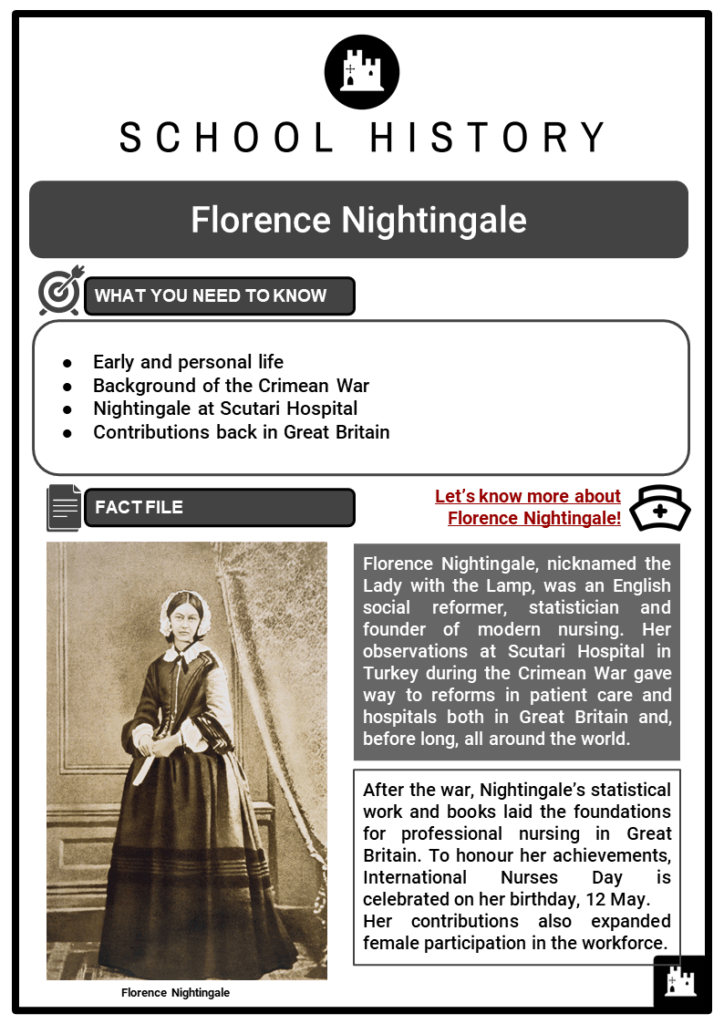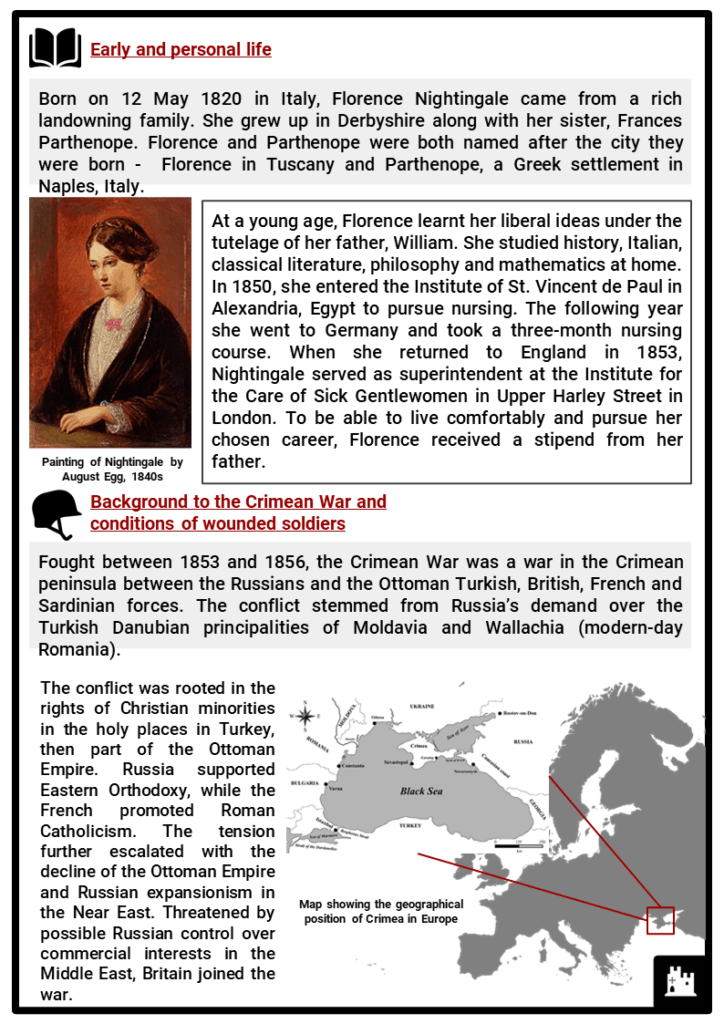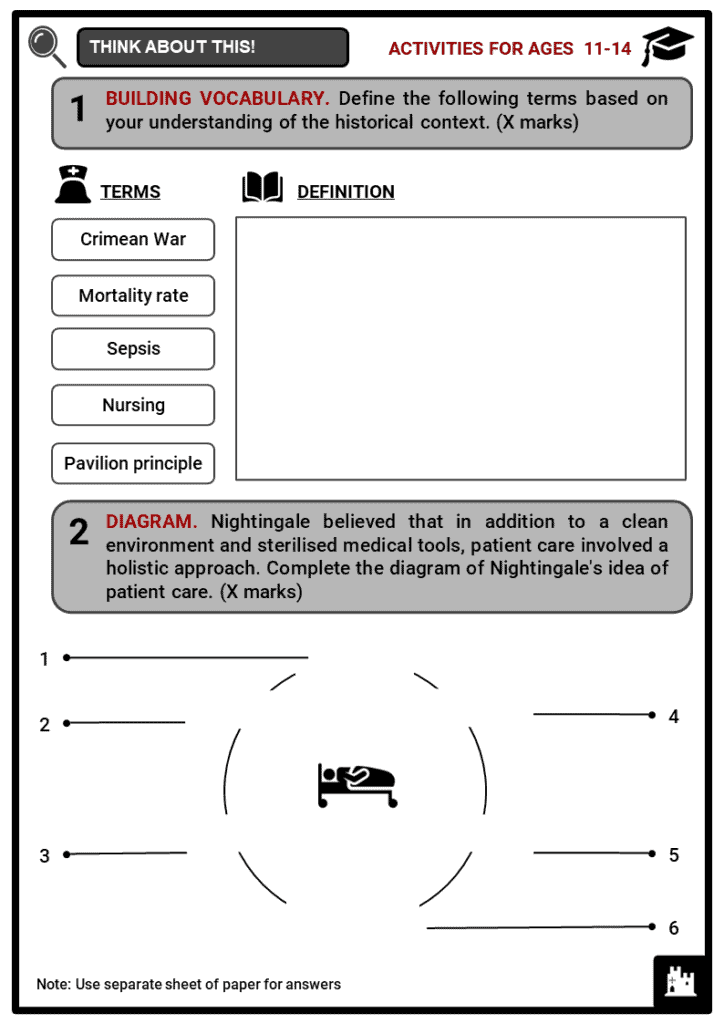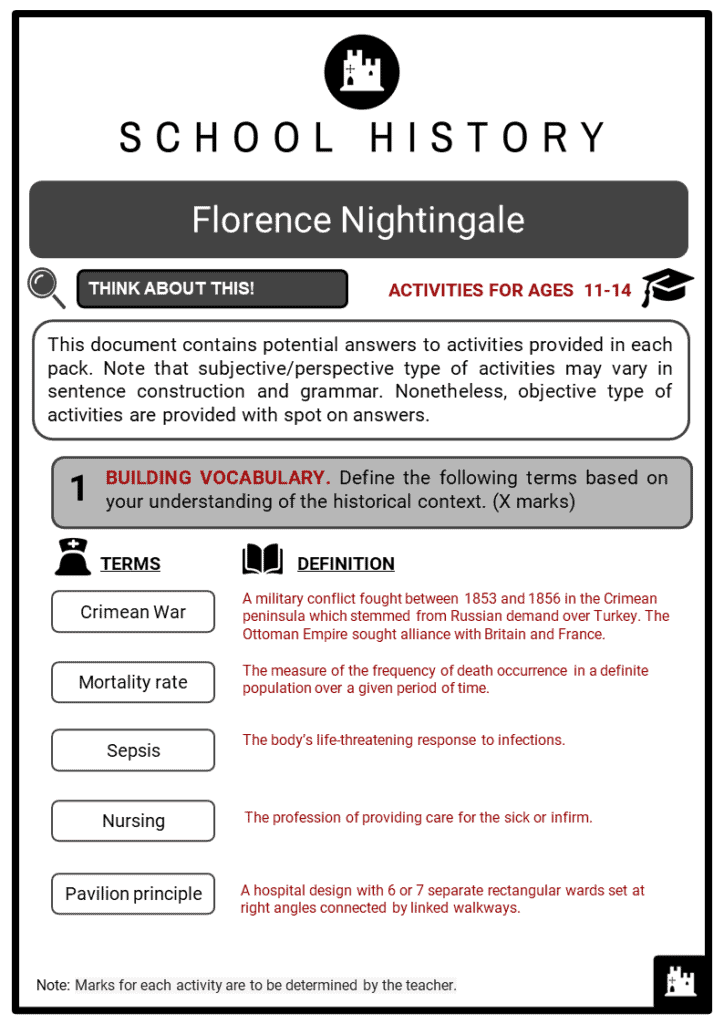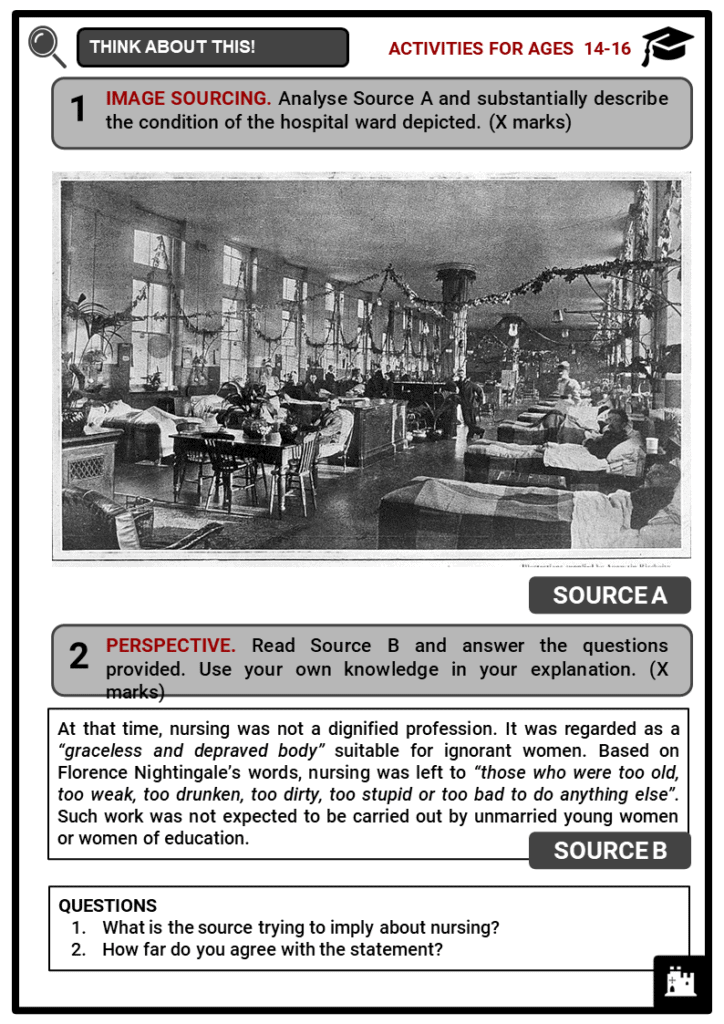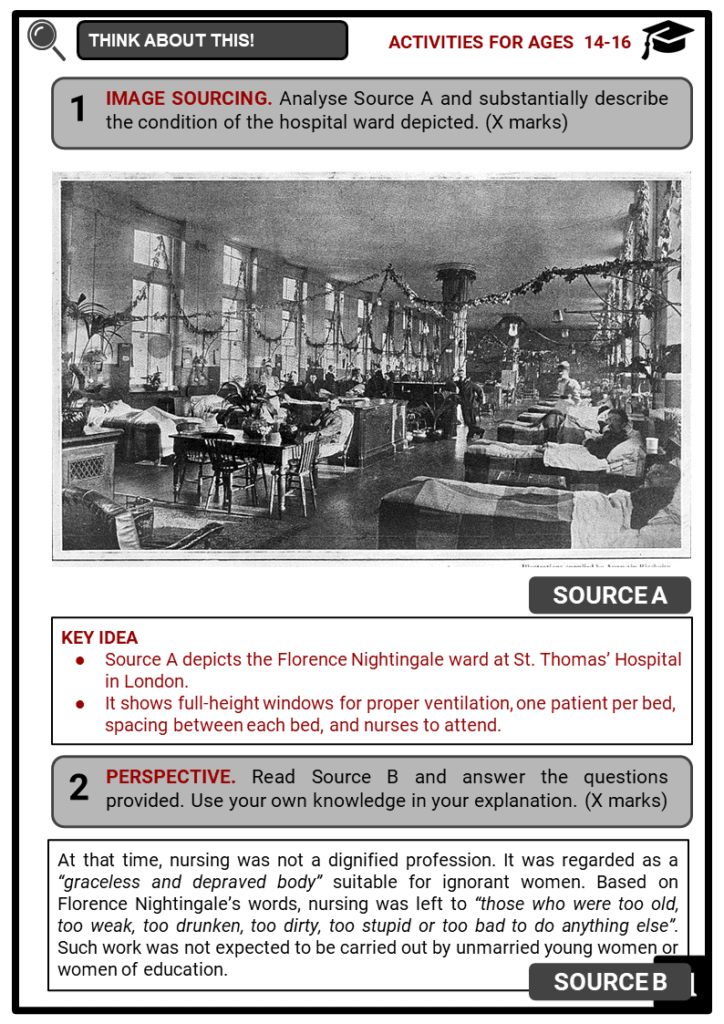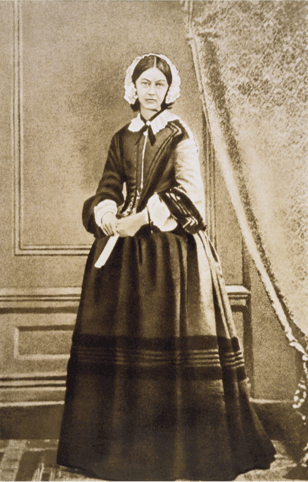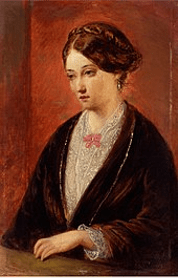Download Florence Nightingale Worksheets
Do you want to save dozens of hours in time? Get your evenings and weekends back? Be able to teach Florence Nightingale to your students?
Our worksheet bundle includes a fact file and printable worksheets and student activities. Perfect for both the classroom and homeschooling!
Table of Contents
Add a header to begin generating the table of contents
Summary
- Early and personal life
- Background of the Crimean War
- Nightingale at Scutari Hospital
- Contributions back in Great Britain
Key Facts And Information
Let’s know more about Florence Nightingale!
- Florence Nightingale, nicknamed the Lady with the Lamp, was an English social reformer, statistician and founder of modern nursing. Her observations at Scutari Hospital in Turkey during the Crimean War gave way to reforms in patient care and hospitals both in Great Britain and, before long, all around the world.
- After the war, Nightingale’s statistical work and books laid the foundations for professional nursing in Great Britain. To honour her achievements, International Nurses Day is celebrated on her birthday, 12 May.
- Her contributions also expanded female participation in the workforce.
Early and personal life
- Born on 12 May 1820 in Italy, Florence Nightingale came from a rich landowning family. She grew up in Derbyshire along with her sister, Frances Parthenope. Florence and Parthenope were both named after the city they were born - Florence in Tuscany and Parthenope, a Greek settlement in Naples, Italy.
- At a young age, Florence learnt her liberal ideas under the tutelage of her father, William. She studied history, Italian, classical literature, philosophy and mathematics at home. In 1850, she entered the Institute of St. Vincent de Paul in Alexandria, Egypt to pursue nursing. The following year she went to Germany and took a three-month nursing course. When she returned to England in 1853, Nightingale served as superintendent at the Institute for the Care of Sick Gentlewomen in Upper Harley Street in London. To be able to live comfortably and pursue her chosen career, Florence received a stipend from her father.
Background to the Crimean War and conditions of wounded soldiers
- Fought between 1853 and 1856, the Crimean War was a war in the Crimean peninsula between the Russians and the Ottoman Turkish, British, French and Sardinian forces. The conflict stemmed from Russia’s demand over the Turkish Danubian principalities of Moldavia and Wallachia (modern-day Romania).
- The conflict was rooted in the rights of Christian minorities in the holy places in Turkey, then part of the Ottoman Empire. Russia supported Eastern Orthodoxy, while the French promoted Roman Catholicism. The tension further escalated with the decline of the Ottoman Empire and Russian expansionism in the Near East. Threatened by possible Russian control over commercial interests in the Middle East, Britain joined the war.
- When British troops arrived in Crimea, they brought only a few ambulances due to limited shipping space. Transport horses were used to transfer the sick and wounded soldiers to a military hospital in Balaclava. However, logistical concerns arose when many of these horses died of hunger and drowning due to the muddy terrain. At one point, the British borrowed French cavalry horses to carry wounded soldiers.
- The British medical transportation system called ‘chain of evacuation’ was poor at that time. Wounded British soldiers were left lying on the battlefield for hours before being taken to a dressing station or basic field tent for initial treatment. Those who were seriously wounded had to be transported on mule litters or ammunition wagons to the port of Balaclava. In addition to seven miles of rough mountain terrain, wounded soldiers also endured severe weather conditions.
- Upon arrival at the port in Balaclava, wounded soldiers waited for hours to be transported to base hospitals near Constantinople. At that time, sea transport from Balaclava to Scutari took two weeks. Aside from dying from their wounds, soldiers suffered hunger and infections.
- Due to overcrowding and unsanitary conditions in transport ships, diseases such as dysentery and cholera spread rapidly. Those who died on the journey were thrown overboard. According to the records of the transport ship Shooting Star, about 47 of the 130 patients died during transport from Balaclava to Scutari. Ships which were built to accommodate about 250 patients actually carried as many as 1,500.
- A year after the outbreak of the Crimean War, over 18,000 wounded and ill soldiers filled the hospitals in the area. At that time there were no female nurses, and wounded and ill soldiers were attended by male military doctors who had minimal help and sometimes limited education.
- In addition to wounds, most British soldiers were dying of neglect and unsanitary conditions. The growing problem in military hospitals in Crimea led Secretary of War Sidney Herbert to engage Nightingale and her own nursing corps.
- With limited knowledge of cleanliness, nurses performed tasks quickly, without washing hands or sterilising tools. At that time, the ratio of army doctors to patients was 4:100. Aside from a shortage of skilled doctors, lack of medical supplies was also a serious concern.
- In August 1854, hospital ships at Varna were taken as troop transporters. Due to insufficient medical supplies, the earlier discovery of anaesthetics had limited impact during the Crimean War. Unlike the British, the French had a better response to medical treatment.
- The French government had a more organised way to get supplies to the hospitals. Moreover, women, including nuns, were encouraged to volunteer to tend to the wounded.
- Infectious diseases such as cholera, typhus and dysentery were proven to be more fatal than gunshots. Unsterile surgeries also caused deaths due to sepsis or hospital gangrene.
Nightingale at Scutari Hospital
- When reports about the appalling conditions of soldiers at Scutari reached Britain, Sidney Herbert, the Secretary of War, authorised Florence Nightingale and about 38 other volunteer nurses to travel from England to Crimea to care for the wounded British soldiers, on 23 October 1854. They were the first women allowed to serve in the British army.
- When Nightingale's team arrived at the military hospital in Scutari, wounded soldiers were in appalling conditions. Scutari Hospital was built on top of a sewer. During rains, corridors were more likely filled with ankle-deep feces and water. Rodents and lice were common on its rotting wooden floors. Patients were overcrowded, just a foot apart from each other. Even after arrival, patients went unwashed and unattended for a long time. Outside the hospital there was a cemetery in which men were buried but scarcely covered with earth.
- After observations, Nightingale, with the support of Sidney Herbert and Dr. Andrew Smith, introduced changes:
- Cleaning of hospital wards, kitchens and laundry
- Purchase and supply of clean towels, shirts and bedding
- Regular changing of bed linen
- Supply of soap
- Use of plates, knives, forks, cups and glasses
- Supply of decent food, majority of which from Britain
- Segregated wards depending on illnesses
- Spacing in between beds
- Improved ventilation
- Rehabilitation of patients through educational and recreational activities, including writing letters
- Inspection of the drainage system by a Sanitary Commission sent by the government
- In addition to patient care, Nightingale pioneered the use of statistical data. Through data analysis, she concluded that wounded soldiers were more likely to survive in hospitals on the home front with only a 12.5% mortality rate, compared to a 37.5% mortality rate at Scutari Hospital.
- Between January and March 1855, two months after the arrival of Nightingale, about 3,354 or 33% of soldiers admitted to Scutari Hospital had died. By April to June, numbers decreased to 342 or 6%. Between July and September, 167 of 7,649 or only 2% of patients died. Statistically, the mortality rate at Scutari decreased from 42 in every 100 to 2 in every 100. In several months, Nightingale was able to decrease the mortality rate among soldiers.
Contributions back in Great Britain
- In 1856, Nightingale returned to Britain. While loss of lives was still prevalent in Crimea, she focused on helping them through research. With the support of Queen Victoria and the government, a Royal Commission into the health of the army was set up. The commission revealed that about 16,000 of the 18,000 deaths among British soldiers were due to preventable diseases spread by poor sanitation.
- The Royal Commission particularly pointed to the following:
- One of the main reasons for high mortality was the spread of endemic diseases such as typhus and cholera. Both are caused by unsanitary living conditions.
- Annual mortality rate among soldiers was 60%
- Between ages 25 and 35, the mortality rate in military hospitals was twice that among civilians
- The work of the commission led to the creation of a department of Army Medical Statistics. The army also adopted a method to classify diseases.
- Florence Nightingale was joined by statisticians William Farr, Thomas Graham Balfour and John Sutherland in analysing army data.
- The statistical contributions of Florence Nightingale during the Crimean War led to reforms in hospital care, infection control and epidemiology in Britain. She highlighted the importance of cleanliness, proper diet and record keeping.
- Long before the establishment of the National Health Service (NHS), Nightingale advocated equal access to medical treatment. In addition to changes in hospice care, she also played a pivotal role in transforming the public image of nursing as a profession.
- In 1859, after successful fundraising, she established the Nightingale School of Nursing at St. Thomas’ Hospital in London. In the same year, the Notes on Nursing was published.
- In her nursing school, Nightingale put emphasis on patient observation for appropriate nursing care. She also introduced decent pay, annual holidays and chances to learn abroad. By 1900, other nursing schools were opened in Britain, the USA, Japan, Australia and Africa. The School of Midwifery at King’s College Hospital was also part of Nightingale’s suggestion.
- Nightingale believed that in addition to a clean environment and sterilised medical tools, patient care involved a holistic approach which included fresh and clean air, proper diet, regular changing of bedding, washing and bathing of patients, well-ventilated and warm environment and nurses’ personal hygiene.
- According to her environmental theory, patient health and recovery could be affected by the hospital building. In her Notes on Hospitals published in 1863, Nightingale put emphasis on providing proper ventilation by adding full-height windows, improving drainage and adding lights.
- She abandoned the earlier design of long hospital corridors. Her ‘pavilion principle’, which consisted of 6 to 7 separate wards set at right angles with connected walkways, was adopted by St. Thomas’ Hospital in 1868.
- Also based on Nightingale’s work, isolation rooms adjacent to the nurses’ station were also introduced. Her work became the foundations of modern nursing and hospital design. She also pioneered the principle of triage or the process of determining priority patients based on conditions regardless of economic status.
- In running hospitals in Britain, Nightingale asserted the following:
- The healthcare team are accountable for the safe and high-quality care of patients
- Positivity in the workplace for a more productive culture
- Hospitals should have good record keeping
- Empathy towards patients
- Professional approach to nursing care
Image sources:

